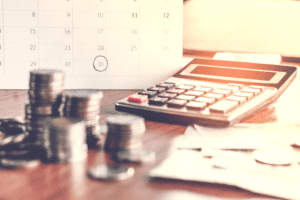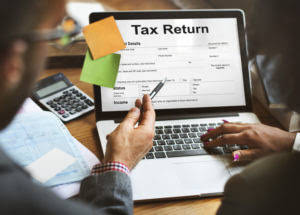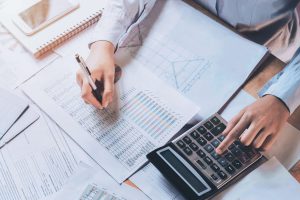Content

An asset’s original value is adjusted during each fiscal year to reflect a current, depreciated value. Accumulated depreciation is the total amount of depreciation expense recorded for an asset on a company’s balance sheet. It is calculated by summing up the depreciation expense amounts for each year. The four methods allowed by generally accepted accounting principles are the aforementioned straight-line, declining balance, sum-of-the-years’ digits , and units of production.

Sum-of-years digits is a depreciation method that results in a more accelerated write off of the asset than straight line but less than declining-balance method. The effect of the straight-line method is a stable and uniform reduction in revenues and asset values in every accounting period of the asset’s useful life. Under MACRS, the capitalized cost of tangible property is recovered by annual deductions for depreciation over a specified life.
Depreciation is defined as the expensing of an asset involved in producing revenues throughout its useful life. Depreciation for accounting purposes refers the allocation of the cost of assets to periods in which the assets are used . Depreciation expense affects the values of businesses and entities because the accumulated depreciation disclosed for each asset will reduce its book value on the balance sheet.
Group Or Composite Depreciationtime
To find the annual depreciation expense, divide the truck’s depreciable base by its useful life to get $5,400 per year. You find that you can sell the truck for $3,000 after five years because you subtracted the cost of the truck from its depreciable base. Depreciation expense is the amount of depletion, as expressed in dollars, that an asset had during the fiscal year. That amount equals the annual depreciation expense for the asset. While the straight-line depreciation method is typically used, other methods of depreciation are acceptable for businesses to use under US GAAP to calculate depreciation expense.
- Charging this expense impacts both the Income statement and the Balance sheet.
- Depreciation is defined as the expensing of an asset involved in producing revenues throughout its useful life.
- The annual depreciation expense shown on a company’s income statement is usually easier to find than the accumulated depreciation on the balance sheet.
- For the sake of this example, the number of hours used each year under the units of production is randomized.
- Without depreciation, a company would incur the entire cost of an asset in the year of the purchase, which could negatively impact profitability.
- The following entry is recorded after the depreciation adjustment for the period is made.
Fourthly, an asset’s “ownership life” is the timespan over which an asset brings a financial impact of any kind. So-called capital projects, for instance, result in capital assets such as buildings, computing systems, or production lines.
Controlling And Reporting Of Real Assets: Property, Plant, Equipment, And Natural Resources
When a fixed asset is acquired by a company, it is recorded at cost . This is know as “depreciation”, and is caused by two types of deterioration – physical and functional. This results in far higher profits than the income statement alone would appear to indicate. Firms like these often trade at high price-to-earnings ratios, price-earnings-growth ratios, and dividend-adjusted PEG ratios, even though they are not overvalued. Other time-based schedules are called “accelerated schedules” because they accelerate depreciation, compared to a straight-line schedule. “Accelerated schedules,” therefore, charge relatively more in early years and relatively less in later years.
Financial modeling is performed in Excel to forecast a company’s financial performance. Overview of what is financial modeling, how & why to build a model. Real estate is a specific industry that requires heavy use of the depreciation schedule.

There are many different terms and financial concepts incorporated into income statements. Two of these concepts—depreciation and amortization—can be somewhat confusing, but they are essentially used to account for decreasing value of assets over time.
What Is The Depreciation Of Expenses?
So the sum of all the years in the asset’s original useful life is 15. Book value is the asset’s cost minus its accumulated depreciation.
Depreciation expense is recognized on the income statement as a non-cash expense that reduces the company’s net income or profit. For accounting purposes, the depreciation expense is debited, and the accumulated depreciation is credited. Depreciation expenses are the expenses charged to fixed assets based on the portion assets are consumed during the accounting period based on the company’s fixed asset policy. The expenses that charge during the period are recorded in the company’s income statement in that period. The accumulation of it is recorded in the accumulated depreciation, the contra account to the fixed assets, in the balance sheet.
Similarities Between Accumulated Depreciation And Depreciation Expense
An example of how to calculate Depreciation Expense under the straight-line method — assume a purchased truck is valued at USD 10,000, has a residual value of USD 5,000, and a useful life of 5 years. Its depreciation expense for year 1 is USD 1,000 (10,000 – 5,000 / 5). The journal entry for this transaction is a debit to Depreciation Expense for USD 1,000 and a credit to Accumulated Depreciation for USD 1,000. When depreciation expenses appear on an income statement, rather than reducing cash on the balance sheet, they are added to the accumulated depreciation account. Double-declining balance is a type of accelerated depreciation method. This method records higher amounts of depreciation during the early years of an asset’s life and lower amounts during the asset’s later years. Thus, in the early years, revenues and assets will be reduced more due to the higher depreciation expense.
- Is an accelerated depreciation method because expenses post more in their early years and less in their later years.
- If the sale price were ever more than the original book value, then the gain above the original book value is recognized as a capital gain.
- Accumulated depreciation is a measure of the total wear on a company’s assets.
- Contributing to the firm’s expenses, however, are three depreciation items totaling $659,000.
- First, to establish account balances that are appropriate at the date of sale, depreciation is recorded for the period of use during the current year.
Its salvage value is $500, and the asset has a useful life of 10 years. The IRS also refers to assets as “property.” It can be either tangible or intangible. Salvage value is the estimated book value of an asset after depreciation. It is an important component in the calculation of a depreciation schedule. A fully depreciated asset has already expended its full depreciation allowance where only its salvage value remains. Investopedia requires writers to use primary sources to support their work.
IT systems, vehicles, machinery and other assets sometimes come with hidden costs that exceed their purchase price. Learn Total Cost of Ownership Analysis from the premier on-line TCO article, expose the hidden costs in potential acquisitions, and be confident you are making sound purchase decisions. Fourth, examples showing how to calculate depreciation expense using four popular time-based depreciation schedules, along with non-time based schedules, and composite depreciation. On a balance sheet, the accumulated depreciation account’s balance is subtracted from the equipment account’s balance to show the equipment’s net book value. The Depreciation Expense Allocations Revisions program allows you to add, change, and delete the allocation for a fixed asset. The Depreciation Expense Allocation Inquiry program and Depreciation Allocation Report allow you to review the detail for expense allocations for multiple fixed assets. To use any of these depreciation methods you’ll need to know the total price you paid for the asset, how much you can sell it for , and it’s useful life.
Calculates depreciation based on the number of units produced in a particular year. The van’s book value at the beginning of the second year is $15,000, or the van’s cost ($25,000) subtracted from its first-year depreciation ($10,000). Now, multiply the van’s book value ($15,000) by 40% to get a $6,000 depreciation expense in the second year. Let’s say you want to find the van’s depreciation expense in the first, second, and third year you own it. Multiply the van’s cost ($25,000) by 40% to get a $10,000 depreciation expense in the first year.
Capital Allowances
The assets that are normally treated as Fixed Assets are an office building or building that belongs to the entity, land belonging to the entity, computer equipment, entity cares, and others. Fixed Assets are treated as long-term assets and reports under the assets in Statement of Financial Position. The debit amount of USD1,000 to the income statement will increase the expenses line of the income statement and subsequently reduce the net income. Accumulated depreciation is incrementally recorded as a value percentage of an asset as it depreciates. Thus the company can take Rs. 8000 as the depreciation expense every year over the next ten years as shown in the depreciation table below. Salvage value – Post the useful life of the fixed asset, the company may consider selling it at a reduced amount. Capital expenditures are funds used by a company to acquire or upgrade physical assets such as property, buildings, or equipment.

If an asset loses 10% of its value each year, for example, after three years, the accumulated depreciation would be 30%. By reporting the decrease in an asset’s value to the IRS, the business receives a tax deduction for the asset’s depreciation. The business is allowed to select the method of depreciation that best suits their tax needs.
Is Depreciation Expense A Current Asset?
Posting depreciation helps you monitor the current status of your fixed assets. To determine when you must replace assets, review each fixed asset’s detailed listing. Journal entry increases the depreciation expense and accumulated depreciation, also known as an asset account. Each asset account should have an accumulated depreciation account, so you can compare its cost and accumulated depreciation to calculate its book value.
How To Create A Depreciation Schedule
Use of this article does not create any attorney-client relationship. Using the facts and circumstances presented, we can use LeaseQuery’s present value calculator to calculate the present value of the lease payments. This is the value we will record for the ROU asset and what will be depreciated.
Tax authorities sometimes permit owners to decide for themselves whether or not a given purchase qualifies as a capital expenditure, eligible for depreciation. You can define an unlimited number of accounts to which you allocate the total expense. The total percentage for all the allocation accounts must be 100 percent or less. Depreciation is a non-cash expense, meaning that there is no cash outflow when the expense is recorded. Suppose an asset for a business cost $11,000, will have a life of 5 years and a salvage value of $1,000. Tabitha graduated from Jomo Kenyatta University of Agriculture and Technology with a Bachelor’s Degree in Commerce, whereby she specialized in Finance.
How Your Depreciation Method Affects Your Income Taxes
Please complete this reCAPTCHA to demonstrate that it’s you making the requests and not a robot. If you are having trouble seeing or completing this challenge, this page may help. If you continue to experience issues, you can contact JSTOR support. Stay updated on the latest products and services anytime, anywhere. FundsNet requires Contributors, Writers and Authors to use Primary Sources to source and cite their work.
https://www.bookstime.com/ is referred to as a noncash expense because the recurring, monthly depreciation entry does not involve a cash payment. As a result, a statement of cash flows prepared under the indirect method will add back the depreciation expense that had been deducted on the income statement. Depreciation expense is not a current asset; it is reported on the income statement along with other normal business expenses. Accumulated depreciation is a running total of depreciation expense for an asset that is recorded on the balance sheet.
Depreciation expense reduces the book value of an asset and reduces an accounting period’s earnings. This content is for information purposes only and should not be considered legal, accounting, or tax advice, or a substitute for obtaining such advice specific to your business. No assurance is given that the information is comprehensive in its coverage or that it is suitable in dealing with a customer’s particular situation. Intuit Inc. does not have any responsibility for updating or revising any information presented herein. Accordingly, the information provided should not be relied upon as a substitute for independent research.
The Depreciation Expense Allocation Inquiry program allows you to locate and review all depreciation expense allocations for a fixed asset from the Asset Master Depreciation Expense Allocation File . Tax rules let depreciation expenses be used as a tax reduction against revenue. The higher the depreciation expense is, the lower the taxable income is—meaning more tax savings. It is important because depreciation expense represents the use of assets in each accounting period. Stakeholders can look at the information and know when to expect replacement assets. Accumulated depreciation is deducted from the original cost of an asset.
Hen a firm buys a long-lasting asset outright, with cash, cash flows at once. With depreciation expense, assets incur expenses over time, as they lose their value to the firm. Under accrual accounting, that is, assets incur “expenses” as they are worn out, used up, or depleted. As a result, owners come closer to reporting expenses as they owe them by charging depreciation expense, each year, across the asset’s depreciable life. Thus, owners receive the tax benefits of paying for the asset over those years instead of all at once. Companies often buy fixed assets for their company, but these assets don’t last forever.

Recent Comments